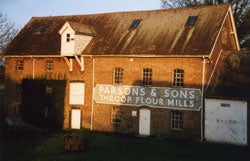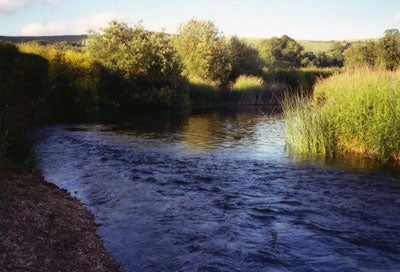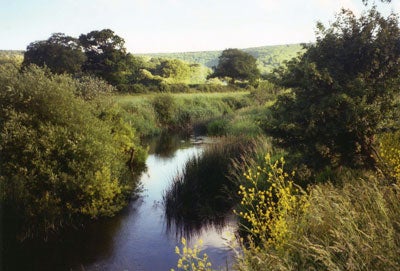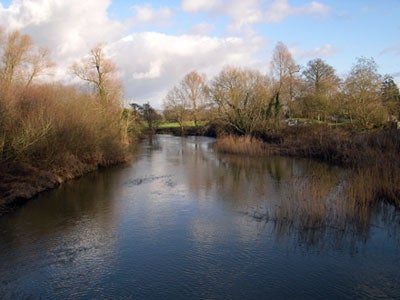| MARK WINTLE |
| Mark Wintle, an angler for thirty-five years, is on a quest to discover and bring to you the magic of fishing. Previously heavily involved with match fishing he now fishes for the sheer fun of it. With an open and enquiring mind, each week Mark will bring to you articles on fishing different rivers, different methods and what makes rivers, and occasionally stillwaters, tick. Add to this a mixed bag of articles on catching big fish; tackle design, angling politics and a few surprises. Are you stuck in a rut fishing the same swim every week? Do you dare to try something different and see a whole new world of angling open up? Yes? Then read Mark Wintle’s regular column. |
| THE UNDISCOVERED DORSET STOUR You could be forgiven for thinking that the Dorset Stour consists of just one fishery – Throop. The constant stream of articles and news items in the weekly and monthly magazines has almost all the big names trying their hand at catching a big Stour chub. Yet, Throop represents a tiny fraction of the fishing available on the Stour. Away from the crowds there are many quiet stretches that are often more interesting and challenging than the publicity drenched beat 2. For the price of a day ticket, or a club membership or two (even a little free fishing), you can gain access to many miles of undisturbed fishing, with the chance of excellent sport. What’s more, there is far more to the Stour than just big chub.
It’s true that your chance of a seven pound chub may be much, much less; and the hyperbole that spawned the claim that a five and a half pound chub is a small one for the Stour will be seen in its true light. The truth is that the majority of anglers that fish these other quieter parts of the Stour have never seen a six pound chub but they enjoy their fishing just as much as those that seek the monsters. Below Throop there are the tidal reaches of the Stour from Sheepwash on Throop’s downstream boundary down to the junction with the Avon at Claypool, and onto the Christchurch Harbour. There are some chub, especially above Iford Bridge, with fish to six pounds, and even a few barbel, too. For me, the beauty of this part of the river is the variety of floatfishing water that responds to many different methods, from bread punch and flake over groundbait with a crowquill Avon, to stick float and maggot (a bit too attractive to the bleak in summer, and caster may be a better bet), to pole-fished hemp and tares.
It is a roach anglers’ paradise when it fishes to form, and there’s a good head of bream and dace as well. Its tidal nature means that the conditions are always changing, and the fish move with the seasons. It’s Christchurch AC water with details and day tickets for much of the length available from tackle shops like Davis Tackle in Bargates, Christchurch. Late season fishing has been patchy in recent years but from June till Christmas it is usually possible to locate the shoals. Be aware that there is plenty of boat traffic in the summer, and that it usually fishes best when there is some flow rather than a standing tide. As an added bonus, there are plenty of mullet in the summer, and some hefty carp (34lbs is the best landed here) in out of the way backwaters. Immediately upstream of Throop there is a long free stretch on the South bank, with access at Muscliff Lane and Brecon Close. Details from Bournemouth Fishing Lodge, Wimborne Road, Moordown (01202 514345). This is mainly shallow and streamy (and weedy) water. You’ll have to put up with the summer crowds of paddlers and dog walkers though the water holds plenty of big chub and barbel. Ringwood DAA, whose club books allows access to Throop, controls the North bank, and this side is much quieter. Upstream at Dudsbury, Christchurch AC control both banks. There are some very big fish here though the head of fish appears much lower than a few years ago.
As you leave the conurbation of Bournemouth behind upstream of Longham so the crowds quickly diminish. Downstream of Wimborne Ringwood and Christchurch clubs control further stretches that can almost be like fishing a lost world, especially at Hampreston. There are some monster chub in these parts. In Wimborne itself the river takes on a very different character, being much broader, deeper and slower. This was the water that the late Owen Wentworth made famous with huge hauls of big roach back in the sixties. The roach are still there in good numbers though the average size is much smaller, and big ones a comparative rarity. Bread still works though. Organised rowing can be a considerable nuisance on this length that is at its best in the winter when there is a good flow and colour. The bonus fish in this area is perch. There are fish over four pounds present, and plenty of two and three pounders have been caught here. Wimborne AC controls much of this water. Details from Wessex Angling, Oakdale, Poole. From Wimborne to Blandford, much of the fishing is virtually untapped. The three clubs previously mentioned all have isolated stretches. It is hard to gauge the potential of the water when there is so little fishing activity. Thirty years ago, the waters below Blandford at Spetisbury and Blandford St Mary were famed for massive dace catches but the Black Death has all but wiped them out. Certainly there are some monster chub, unknown barbel potential, big perch, and one should never forget that the river at Corfe Mullen produced the record roach. The question is whether one is brave enough to investigate the river and suffer the inevitable blanks, and yet who knows just what is in this length? The sort of angler fishing this bit of river is likely to keep their catches very quiet so there is nothing to go on. Rumours of a ten-pound plus chub netted during an electro-fishing survey last summer still circulate… As we reach Blandford, so we finally are on what is by far my favourite part of the river, the Upper Stour. Several clubs have water in this area. Between Blandford and Child Okeford, Dorchester DAS have the longest stretch, though Ringwood, Eastleigh and Christchurch books will also get you onto a lot of water. Much of this water can be like a slow moving, lily lined canal in summer, as it is held up a series of weirs. There are natural reaches of river where there are pools and riffles with lots of overhanging trees, weedbeds and other features. Roach abound with the odd big one. Small chub, dace and perch are abundant, and the pole angler can have some interesting sport. Bream are to be found in small shoals here and there. Whether barbel, introduced several years ago, will establish themselves remains to be seen. Although location can be a problem, there are chub to six pounds, roach over two pounds and perch over three pounds in these stretches. Casters are often the key to success in summer to beat the ubiquitous minnows.
From Child Okeford upstream to the outskirts of Marnhull the Sturminster and Hinton club have the majority of the fishing. Like the river further downstream weirs hold much of this back but again there are some stretches of natural river. Sadly, this part of the river has had some serious pollution over the years with silage effluent being the main culprit. But some significant restocking by the club means that the river is coming back strongly now. The mix of fish is similar to that downstream. One additional bonus is that there are tench present in some areas of the river here. Day tickets are obtainable from the garage near Sturminster Newton Bridge, at £ 5 a day. The Stour diminishes rapidly upstream of Sturminster as several tributaries enter the river between here and Marnhull. From a river that is fifteen to twenty yards wide, you suddenly have a river that is often as narrow as five yards. It can be deceptively deep with pools to fourteen feet. The variety of fish changes too. There are very few perch, and the chub are mostly small. There are some pockets of very big roach. If you live in this area the best bet would be a Gillingham permit as they control the majority of available water in this are. It has been a whistle-stop tour, and only a taster for what is available. When I took Andy Nellist, Graham Whatmore and Nigel Connor fishing at the end of the season to a stretch near Child Okeford, I think that they were amazed at the wealth of interesting fishing away from the crowds at Throop. NEXT: ‘The Price of Fish(ing)’ |

















